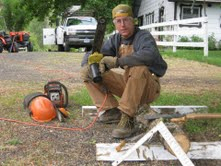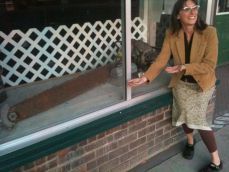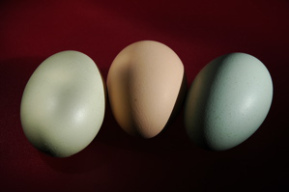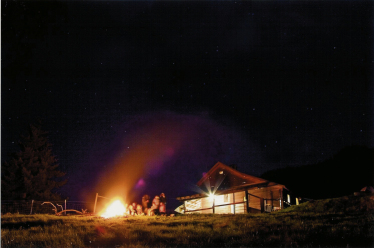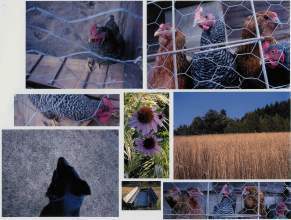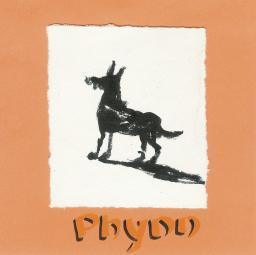Kristy Athens's Blog, page 14
August 5, 2012
Summer Parties on the Land
When Mike and I lived in Portland, we threw hum-dinger Winter Solstice parties. We played ‘60s Christmas record albums scrounged from estate sales, projected the original Grinch cartoon on a wall in the kitchen, and walked around with trays of freezer-cold shots of Rumple Minze in our grandmas’ crystal cordial glasses.
As the first winter in our new home in the country approached, we did the math: copious liquor + driving 70 miles + sunset at 4:30 = DUIs and possibly blood on our hands.
We decided to switch to a Summer Solstice party.
Success! The parties started in the afternoon for the children’s-bedtime-slaves and continued late into the night for the rest of us. We grilled like mothereffers: Sausages! Salmon! Veggies! Veggie sausages! Whatever people brought, Mike or my dad slapped on the grill.
In the evening there was a fire. The first year, we had an enormous bonfire fed by downed trees and unsalvageable lumber (documented by Pete in an earlier blog post). Subsequent years, with drier weather, brought smaller fires in a metal fire ring in the middle of the driveway.
The year of our final Solstice party, in 2009, Klickitat County’s burn-ban started extra-early. There could be no open flame of any kind, not even in the middle of the driveway. Undaunted, Mike set out an oversized 1970s table lamp, connected to a string of electrical cords, and surrounded it with chairs. Humans, primal creatures that we are, surrounded the “lamp-fire” all night.

Cowboy Dan croons in front of the lamp fire (photo: R Frestedt)
We moved our car and pick-up out of the garage to make room for strawbale seating, potluck dish tables, and games. We tried to set up croquet but our ground, even on the “lawn,” was too bumpy; it was too windy for badminton. Ping pong and foosball, on the other hand, lasted well into the night.
The beauty of throwing a party at your house isn’t limited to living in the country: You can get as junked as you want—because you’re already home! The beauty of throwing a party on your own land is that your friends can be there, too. When the sun finally set over our cedars and firs, the tents went up around the fields. A few people popped the tops on their campers. A few slept on the living room floor. All were welcome; it was much better than trying to drive home.


July 29, 2012
A Heart of Cheese
On Tuesday my book tour schedule brings me to the Midwest, what I like to refer to as “The Old Country.” I say that because I am, at my core, a Midwestern woman. No matter how far I roam there is still a Minnesota girl inside me.
There’s also a Wisconsin girl. My parents were dual citizens, born and raised in Wisconsin but who moved as adults to Minnesota. They rooted for the Vikings—unless the Vikings were playing the Packers. They always root for the Packers. I went to first grade in Milwaukee, and my sister was born there. My mom, to this day, refers to visiting our relatives in Wisconsin as “going home.”
Minnesota and Wisconsin share one of those regional rivalries that is all-too-real to the invested parties and incomprehensible to anyone else. In Oregon, where I live now, people don’t even know where these states are, let alone any silly subtle nuances between them. But ask a native Oregonian about California and you’ll get an earful.
The Minnesota-Wisconsin rivalry is less vitriolic than the Wisconsin-Illinois rivalry, and more substantive than the Minnesota-Iowa rivalry. I mean, really, what is the difference between southern Minnesota and Iowa?
To the trained eye, this is not nuance:
Minnesota Wisconsin
Protestant
Catholic
Scandinavian
German/Dutch
Twins
Brewers
Sausages
Walleye
Perch
Mayonnaise
Butter
Stocking cap perched
on very top of head
No hat
Ford
Chevy
Pepsi
Coke
Sweet white wine
Beer
Coffee so weak it looks like tea
Beer
Those Germans drink beer all the time, even on Sunday. Scandalous.
Most of my heritage is German (and Dutch, another one of those differences that no one but the invested parties can discern). My great-grandmother Hazel provided a splash of Scotch-Irish, English and French. I assume that this one aberration in my genetic code is responsible for my love of whiskey and dry red wine. The rest of me is cheese, sausages and beer. Ein Prosit!

July 22, 2012
Hooray for Clarissa the Sheep!
In March, Mike, mother-in-law Kathy, and I packed up our car for a Trip to the Country. On the docket: shooting promotional video for Get Your Pitchfork On!. The weather was iffy at best, but it was the only weekend that we had our friend John’s camera and that would give Mike enough time to edit the video before the book came out at the end of April.
As we drove west from Portland to the country home of friends Shari and Joe, dark gray clouds hung in the sky. A bit of rain spattered the windshield. We had brought about ten extra layers for Kathy, who is notorious for under-dressing for the weather. She would doubtless refuse to wear them, but at least they were available.
We pulled into the driveway of our friends Shari and Joe, and were first greeted by their dogs, giant Harlequin Great Danes named Patch and Spot, and black Lab Bowman.
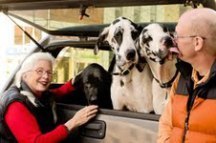
Patch gives Joe some love
It felt good to don my country hat, which mostly lies fallow on a shelf near our front door. My plaid wool shirt felt better than when I wear it in the city. And I put on my knee-high rubber boots, which I wear to take out the garbage more from nostalgia than any actual need to wear boots.
Until the equipment was ready, I had nothing to do but get cold. While Mike carefully arranged cables and tripods, he caught sight of me, shivering and rubbing my arms together.
“You look miserable,” he said. “Go run around the field to warm up.”
When I returned, Mike had set up under a lean-to to keep the camera dry. I, however, was out in the yard. It was the kind of misty, cold Oregon day that seeps into one’s very marrow. Even the stalwart Kathy had accepted an extra jacket and gloves. In between takes I jumped up and down, and blew warmth into my cupped hands.
By the time we went to Shari and Joe’s neighbors’ house, it had cleared and warmed up some. Heather and Robert have three sheep, Mopsy, Flopsy and Clarissa. The animals were usual sheep, curious but nervous. They would come sort of close to us but, as soon as someone moved or reached out a hand, darted away. Being herd animals, they acted as one unit.
Being livestock, they were also easy to entice with feed. Robert had a trough at the ready while Mike and Kathy set up the shot. When Mike gave him the high sign, he put the trough down and jogged away from the shot.
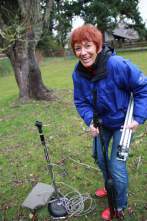
Key grip Kathy!
I began to deliver my lines, with Mike giving direction and prompts: “Where can one find this book?” “Do you have a website?” “Why is this book different from other back-to-the-land books?”
At one point, I delivered the wrap-up and Mike said, “Okay—fast! Do it again. There is a sheep standing next to you.”
I looked down and there was Clarissa, who had abandoned her sisters at the trough. I hadn’t even noticed her. What luck! I quickly ran through my pitch again and again, as many times as I could while she was there. She eventually lost interest and wandered off, but I felt like the luckiest person in the world.

July 15, 2012
Guest Blog: Writing at Husum
When I lived on my land, I started a monthly drop-in writing group called “Time to Write.” Friends came to my house with their pads of paper, journals or laptops to work on their poetry, fiction, letters to the editor, whatever. Some came every time and others every once in a while. We worked all morning and then shared a potluck lunch.
Susan Hess, one of the TTW regulars, contributed to all of the area’s publications. The following is a piece that ran in the Hood River News in 2006 as part of Susan’s column, “Second Story Views.”
Writing at Husum
By Susan Hess
I always sit in the same place—the southwest corner of this farmhouse. I get to come here once a month. Saturday morning. And write. Two hours of quiet. Peace really.
I hear cars going by on the highway, but we’re just far enough away that the sound comes here muted. Out the window to my right, the branches of a giant fir tree drape down. New brown cones bristle at the tips of the branches. In a field beyond the fir, is an oak tree—not chopped up to make way for electric and phone lines like in the city. This one is the way oaks grow in an open field: full, exuberant. Its dark green leaves cluster letting the tree’s structure show through.
Behind the oak, a ridge rises several hundred feet high. A dense conifer forest grows up its hillsides. Between the ridge and where I sit is a grassy field—that honey color of late August.
In the next room, “Moon River” is playing on the CD.
The window ahead of me is half-covered by Big Leaf maple. Its canopy shades the south side of this house. From my seat, I look up into the leaves fluttering in an occasional breeze.
Today is the end of my first week of vacation, and today my mind feels like energy has seeped into every part of it.
I sit here in a house surrounded by farm fields. Beyond the maple tree I look out across the grass to a linear grove of cottonwood trees. A Ponderosa pine guards the front of the group.
It’s sunny, warm outside, but cool in here. A nearby window is part way open. Out the east window, a stack of firewood sits on the front porch.
The house offers the comfort old farmhouses give when they’ve been added onto here and there through the years, and added onto for comfort not style. It comes from all the wood used. The windows and doors are trimmed with four-inch-wide fir stained dark. Windows wood framed. And it comes from open doors and windows, a garden out back and from the owners opening the house to friends and family.
Here, I hear no sirens or trains rushing by. There’s lots of sky and sun and shade. And now and then I feel the breeze pushing through the open window and brushing across the floor.
And I can write.


July 8, 2012
The Art of Value-Added Products
For the most part, Get Your Pitchfork On! deals only with “farming” for one’s personal use, not for retail sale and certainly not for wholesale. However, I do discuss the idea of improving your profit margin on farm-based products by processing them into something more preserv-able and elaborate. This is generally known as “value-added.”
Take raspberries. Delicious. A country favorite! But they are extremely delicate and spoil quickly. If you plan to sell raspberries, your choices are:
Minimize transportation by selling them at the end of your driveway, or hosting a you-pick field (which brings a raft of other considerations).
Package them in those decidedly not-environmentally friendly plastic clamshell boxes.
Expect a large rate of damage, which is basically a financial loss (even if you eat the “losses” yourself).
But—if you take those same raspberries and make them into jam, syrup, or any number of other food items, you not only increase the price and eliminate loss by damage, you have something that travels well and has a much longer shelf-life.
Same with something like lavender. As a fresh crop, it’s basically just good-smelling purple flowers on sticks. But take those flowers and weave them into a wreath, or strip the flowers into a potpourri, or twist them into “fairy wands,” and you’ve got yourself a lovely home décor item! Or, get a little more involved and crush them to extract the oil for soap, lotion and other toiletries.

My mom makes beautiful “fairy wands” with her lavender
Splitting firewood is adding value. My friend Jon, who lives in Enterprise, Oregon, saw those $5 piles of firewood that people sell to campers and thought, “I can do better.” So, how did he improve on a great idea? Under the auspices of the Wallowa Mt. Campfire Company, he makes bundles that include matches, newspaper, kindling, and s’mores fixin’s, just for fun!
The best value-added item I’ve seen to date was brought to my attention by my friend, Annie, who was traveling through Sisters, Oregon. Her hotel’s grounds featured a small corral of resident llamas. The owners were really smart and, in their gift shop, stocked little stuffed llamas to which they added tags noting which llama it represents and a short description of her. Not only that, they named the llamas after human celebrities. Meet “Tori Amos” …
Brilliant! The hotel owners created a tangible item for a “product” that previously only existed as a memory. Now my friend could take home more than a photograph, and the hotel could keep a little bit more of her money.

You can’t take home a real llama, but you can take home a stuffed one!








July 1, 2012
It’s Not the Size That Counts …
The chainsaw controversy continues! A few weeks ago, I noted in this blog that my friend Monica took exception to my having characterized her 12” electric chainsaw as a “child’s toy” in Get Your Pitchfork On! To be fair (to me), I said it looked like one in comparison to the chainsaws I’d seen ever since I moved to the country.
Turns out, this characterization also struck a chord with my friend and former neighbor, Jim Tindall. Jim wrote, “Don’t mock little electric chainsaws. [My wife] Pam was doing a training out at Big Sky, Montana, and I passed some time by visiting a second-hand store. I picked one of these up for $5, and it is one of my favorite tools now. While it does require juice, it is far, far lighter than my 24″ bar or my gas-powered 12″ bar. It makes using a chainsaw on a ladder (a stupid death-wish idea to begin with) safer.”
I asked him to send me a photo of him with his toy. Being a good sport, he did, replying “It’s not a frickin’ TOY!”
Geez, these country folks can get touchy about their tools. Jim sent a nice photo—it not only shows his electric you-know-what but also his gas-powered saw, with the tractor and the rig thrown in the background for good measure. He artfully trailed the saw’s extension cord across the driveway.
While we’re here, please note the safety equipment: gloves, boots, full sleeves and pants, hat/helmet, protective eye wear, and—for the noisy two-stroke-engine—earmuffs. If this were a big job, I would add chaps (not the rodeo kind).
During my recent trip to Eastern Oregon, I discovered a means of ending this controversy the ‘Merican way—sheer overpower. Displayed in the front window of this barbershop in Burns, my friends, is a chainsaw:
I rest my case.








June 24, 2012
Country Frame of Mind
Driving east from Bend toward Burns, I made an impulsive stop at the Oregon Badlands Wilderness, a new set of trails. Well, the trails have been around for eons but they have recently been acknowledged with trailhead maps, parking areas and Bureau of Land Management protection (locals are no longer allowed to dump their garbage and old mattresses there).

Oregon Badlands Wilderness
Since I wasn’t used to hot weather and it was at least 80 degrees, I didn’t hike in far enough to experience the area’s claim to fame—petroglyphs in rugged lava canyons—but I was able to see ancient junipers, a few stalwart desert flowers, and acres and acres of sagebrush. Occasionally the dusty, soft volcanic pumice trail would yield to the underlying black lava that forms the area.
I had tried to text a photograph of the trailhead to Mike, both because he would be interested and for the sake of safety (I was deviating from my announced trajectory and I was alone), but my phone couldn’t find a signal. I was slightly distracted by the fact that the iced tea I’d drunk while on Bend’s fancy main drag just 30 minutes prior had worked its way through my system and wanted out. Forgetting the phone, I trotted over to the nearest large juniper and dropped trou. Ducking behind a tree was an unnecessary formality, as there were no other human beings for miles.
My mind was still in city mode, hurling thoughts about what I needed to do when I got to Burns, when I got home, when I returned to work, in rapid succession. I had forgotten to tag the blog post I’d made hastily while the hotel staff waited for me to clear out of my room. I had forgotten to send an email to my gracious hosts at the Nature of Words. I had forgotten to email my publicist about a trip to New York. I needed to ask my husband something. Oh, and ask him about that, too. And that, too.
I kept walking.
As I continued, observations of my surroundings slowly supplanted the endless banter of current and future obligations. Meadowlarks called to each other. The wind blew my hair and lifted the odor of baking sage to a swirling perfume. My feet crunched softly in the pumice, and the sun beat down on my hastily sunblock-slathered shoulders.
I kept walking.
The wind was huffing across the expanse of high desert; I limited my pace to accommodate breathing through my nose, for the hot air threatened to scour my open mouth of moisture in seconds. It whistled through the gnarled juniper branches and jostled the stalwart desert flowers that managed to survive on a few inches of spring rain.

Stalwart little monkeyflower
I stopped to admire a monkeyflower, which danced playfully in the breeze. It seemed to me that most desert plants grew yellow flowers because they take less energy. I considered the showy hibiscus of the tropics. The monkeyflower fit the theory, true or not: it had a beautiful bright magenta flower but the plant itself was about three inches tall, much shorter and smaller than those with small, yellow blooms.
When my mind had quieted and I’d put a good dent in the water I carried, I turned around. By the time I returned to my car I had entered country mode, and I was ready to continue my journey into Eastern Oregon.








June 17, 2012
In the High Country
The first thing that hits you crossing the Cascades into Eastern Oregon, besides the stark beauty of rim rock and sagebrush and the majesty of the Three Sisters and their friends looming to the west, is the dry. Within an hour of arriving in Bend, my thirst is unquenchable and my lips shrivel into little crusts.
At last night’s reading, in the still-relatively-new Nature of Words Center in downtown Bend, one of the people in attendance was a woman who moved here from Nashville. My words about the ease of gardening in the Willamette Valley struck a chord with her.
“I came here in August and saw these little bitty tomato plants,” she said. “I thought they were diseased or something.”
“This is high desert!” said another woman.
I asked if she liked the dryness as a climate feature, though, compared to the humidity of Tennessee. She agreed, but then her friend asked how it affected her skin.
“My skin is a wreck!” she laughed.
Today I will head east to the town of Burns, where I wrote a good half of Get Your Pitchfork On!, and then north to visit my favorite towns of Baker City and Enterprise. More on that next week! I promise to drink plenty of water.

June 10, 2012
Farm-Inspired Art
When friends came to visit us in the Gorge, the beauty of the farm often moved them to take photos or create other artwork.
Gary Sharp runs the library in North Bend, Oregon. I brought him some eggs when I went there for work. He loved the colors so much he took some photos for his blog. (In case you’re wondering, those eggs belong to Yolanda, Sylvia and Natasha, respectively.)
Pete Springer attended one of our summer solstice parties and shot this amazing picture of folks gathered around the bonfire, behind our barn. He’s now a professional fashion photographer, and you can see why.
My mother-in-law and my own mom are both masters of rhyme; my MIL-ly writes clever birthday cards extolling the recipient’s virtues, while my mom emails my sister and me adorable couplets about a rainbow she’s seen or some cherries she’s eaten. Once, after I made my parents help plant the garden on a visit, she sent this free verse:
“A drive through beautiful gorge scenery
greetings and visits with the chickens,
manual labor to help create appreciation for the
delicious grilled tuna, mushrooms and superlative
peach-huckleberry pie. A splash of wine and some tall tales to boot.
And what a breakfast! A little more manual labor and another trip back through the
Breathtaking Columbia Gorge on a sunny day.
A very nice visit indeed.”
If you’ve read Get Your Pitchfork On!, you recall the generous individuals who came out to help us work on fire abatement in our woods … with an electric 12-inch chainsaw. Monica recently informed me that she and her wife Karen have “cut down two 60-year-old apple trees on our property with that same ‘toy.’” Okay! Monica created this photo collage after a visit.
When our dog, Phynn, was hit by a car, friends Dan and Melanie sent this card. Dan’s an oil painter whose work is available in Portland. If you can afford it, I recommend investing in him now.
My sister, Linda, is also a shutterbug! One of her thank-you cards featured chicken Yolanda in mid-shake. Action shot!

June 3, 2012
Guest Blog: How to Get Rid of Grasshoppers
I met Diane Sward Rapaport while I served as writer-in-residence in Harney County, Oregon, in 2009. She has led a colorful life, not the least of which includes managing the band The Pointer Sisters in the 1980s, and has written a number of books about the music industry. Diane mentioned that I missed grasshoppers in my section about insect pests, and she is right! I’ve started a list of things to add in case there is ever a second edition of Get Your Pitchfork On! Meanwhile, I asked her to fill us in.
This is the first of, hopefully, many guest posts. If you are interested in appearing on the GYPO blog, please let me know. Share your moving-to-the-country experience!
Diane is currently working on a book about her time in Arizona entitled Home Sweet Jerome. This post is an excerpt:
How to Get Rid of Grasshoppers
By Diane Sward Rapaport
During a grasshopper infestation in Jerome, Arizona, in the early 1980s, I asked local gardeners what to do and got a number of answers:
1. Shake some diatomaceous earth on your plant. It contains ground-up skeletons of algae-like plants called diatoms, which contain lots of calcium, silica and other trace minerals. When the grasshoppers eat this, it cuts their intestines to pieces and they die.
2. Use an environmentally safe product like Nolo Bait, which infects them and cuts down on germination.
3. Distribute bottles containing one part molasses with ten parts water. The grasshoppers will jump in and not jump out.
4. Spray your plants with a mixture of soap and hot chile peppers.
5. Put garlic in a food blender, mix with water and spray it on the plants.
6. Go out early in the morning when the grasshoppers are sluggish and gather a bunch of them. Put in a blender and spray the plants with the mixture.
7. Get a battery-operated tone generator tuned to a frequency they don’t like.
8. Use more mulch so they can’t hatch.
9. Plant enough for you and the grasshoppers.
10. Put a larger fence around your garden and keep chickens. The chickens will eat the grasshoppers, and besides, then you’ll have fresh eggs and lots of fertilizer.
11. Get toads. Toads will eat anything that moves. There’s a lot of ‘em down at the Verde River.
12. Spray the plants with hair spray. They hate it.
13. Spread powdered sugar on the ground. The grasshoppers will eat that instead.
14. Connect a hose to the exhaust of your car, start it up, and hose ‘em with carbon monoxide.
15. Sprinkle bran on the plants. They eat it and explode.
16. Poison ‘em with Malathion 50 (or other insecticide).
17. “I don’t know. But I’m going to need an answer soon!”
18. If all else fails, you can eat them. Fry them up in a little olive oil—crunchy and tasty if you have good stuff growing in your garden.
After eighteen suggestions for entirely different solutions, I stopped asking. I understood why Jerome is sometimes called a town of 400 people and a thousand opinions.



